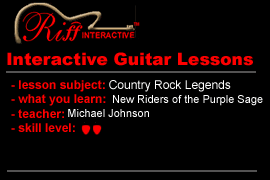Scroll through the lesson and click on notation/video/audio links to load the interactive players.
Please subscribe to get full access to all lessons for only $7.95/month PLUS 1 week free trial.

Riff Interactive lessons are
LESS expensive and
MORE interactive than alternatives!
More Info
|
|

Teacher: Welcome class to our lesson on
Country Rock Legends. This lesson will cover New Riders of the Purple
Sage. New Riders of the Purple Sage actuaslly started in '69 with John
Dawson and Jerry Garcia. They actually started what was coined "Cosmic Cowboy"
sound. Phil Lesh and Micky Hart also played in the band. Of course those
players would start the Grateful Dead. Check out the lesson samples of what you
will learn.
Lesson Sample -
Lowband - 598k
Lesson Sample -
Highband - 1.2 Meg
Teacher: Let's get
started. Our first part will be a modified country-rock progression in C. Here's
the rhythm.
Part 1
- Rhythm Guitar
Teacher:
This rhythm steps outside of a typical 1, 4, 5 major country progression. Very
common with modern country as well. Notice on C you have an alternating bass
note. This is common in country rhtyhms. Next you have pickup notes that
lead into F, which has the same alternating bass notes and back to C. The change
shifts to Am, then C, G and E. So basically you play around with chords that are
all related to the key of C.
walker: do you bar the F?
Teacher: You don't have to in this case
Walker. Here's a jam track, load this file and practice over it, and we
will later play licks over the
progression.
Looping Jam Track 1 - Lowband
Teacher:
Let's go over some country rock licks. Here's the first
lick.
Part 1 -
Lick 1
Part 1 - Lick
1
Teacher:
This licks use all triple-stop licks. These licks mimic the sound of a steel
guitar. Notice how the 4th finger bars the 1st & 2nd strings, while the 3rd
strings bends on the 3rd string (G). Jerry Garcia actually started with New
Riders so he could practice playing steel guitar. Country and Country Rock
players try to cross the sund of guitar and steel guitar at times. Also notice
you are moving positions that related to the chords. For this lick you are
basically changing Major Pentatonic positions that relate to the chords in the
progression. Let's try another lick.
Part 1 - Lick 2
Part 1 - Lick
2
Teacher:
These licks are played over the Am portion of the progression. Starting
with Am, then over C, G, and E. Playing over these chord changes can sound
very melodic. The trick is to visualize the chord progression in your head
and get use to changing the licks over the progression. If you have a hard time
remembering the chords, write them down on a piece of paper. There is an
open D note before the E. Notice the hammer-on in the E chord. The video will
help as well to visualize the patterns. Also I need to point out that when
playing C you play an ascending C Major Pentatronic scale. Here's the next
lick.
Part 1 -
Lick 3
Part 1 - Lick
3
Teacher:
This section of licks follow the chord progression playing all Maj 3rds &
Min 3rds. Using these intervals add a pretty cool melodic sound. Notice how you
bend some of the notes on the 2nd string. This section is played over the C
section of the progression.
Part 1 - Lick 4
Part 1 - Lick
4
Teacher:
This lick jumps back iinto the triple-stops again. This time you play some
variations on the lick theme we played in the previous triple-stop licks. In
this lick you can see how you can create the steel guitar sound. For some reason
triple-stops sound more like a steel guitar in the upper register of the neck.
Here's our next lick.
Part 1 - Lick 5
Part 1 - Lick
5
Teacher: This section follows the Am
portion of the progression.
rocknjosh: Hey teach what kind of an
effects are you using to bring out that go twang sound besides just a clean
tone.
Teacher: Rock, I'm using a Tele
through a slapback delay on a clean setting. It's pretty
basic.
walker:
The key to the clean sound is the finger picking i bet, it doesn't sound as good
when playing with a pick
Teacher: Walker, great point. Yes the finger
picking brings out the attack of the notes. Here's our next
lick.
Part 1 -
Lick 6
Part 1 - Lick
6
Teacher:
This lick uses the same formation of the triple-stops, but notice you play
descending notes. It sounds very cool to mix playing the triple-stops and
single-notes. Make sure you try playing these licks over the looping jam
track. Here's the next lick.
Part 1 - Lick 7
Part 1 - Lick
7
Teacher:
Here are some common country licks that use the chord pattern. You're basically
adding notes using hammer-ons and techniqes like that. Playing these alternation
of the chords is easier than trying to move Major Pentatonic positions while the
chords change. I need to point out The Eagles used a lot of these technique,
especially in the early years and were influenced by New Riders, Poco, etc. So
this lesson show some good fundamentals for the up coming Eagles lesson. Here's
the next lick.
Part 1 - Lick 8
Part 1 - Lick
8
Teacher:
Here are more chord/lick combinations that are played over the Am section of the
progression.
Teacher: Any questions on the
lesson?
walker:
thanks for the great lesson.
Teacher: Yes, it will take some time to get use
to playing over the chord changes. Well lessons over, so I will see you next
week
bones: thank
you
Teacher:
bye!
Hunter:
Thanks, Michael
|
<< load notation from left
|
|
<< load audio from left
|
<< load audio from left
|